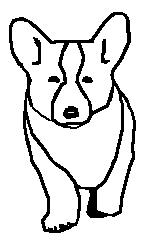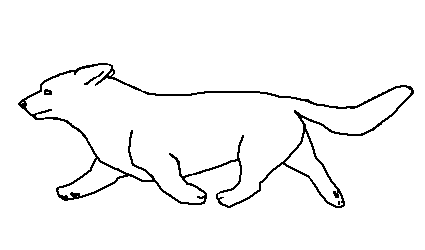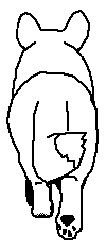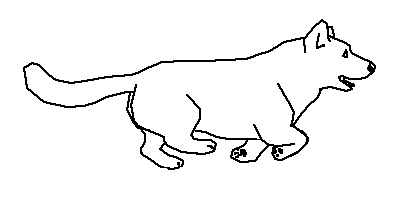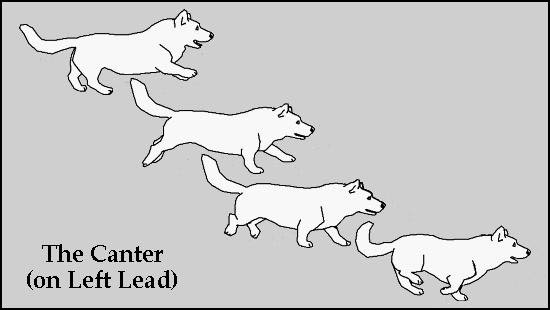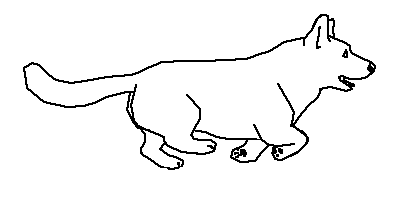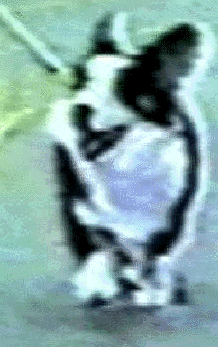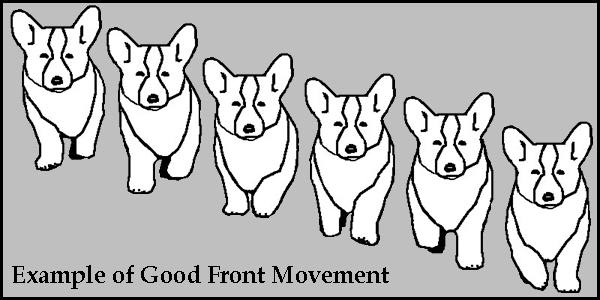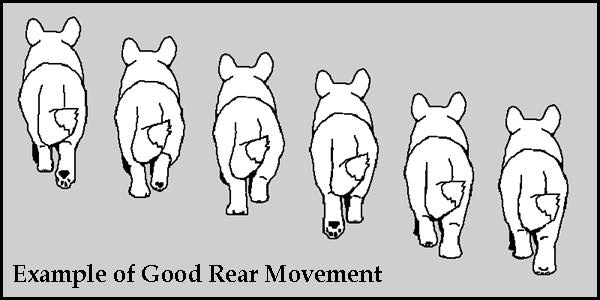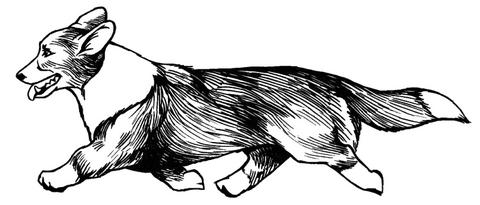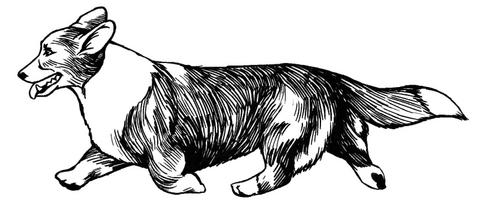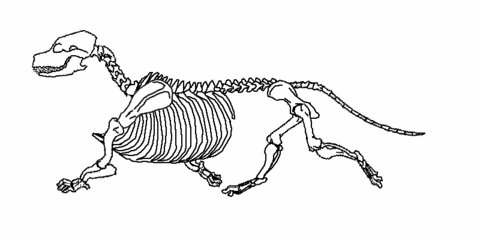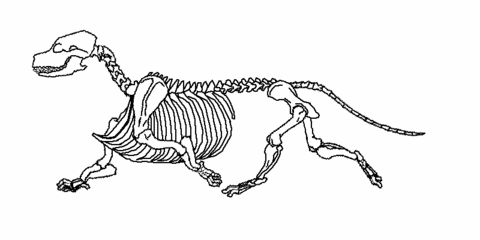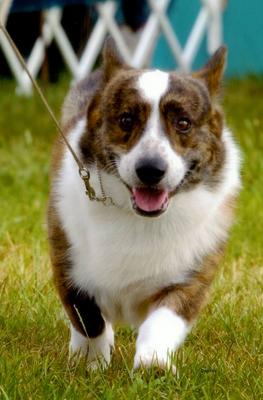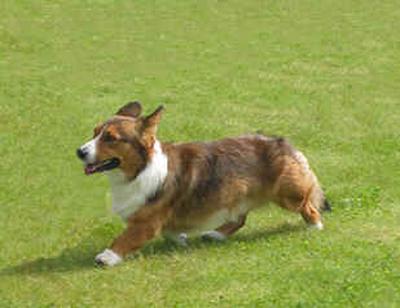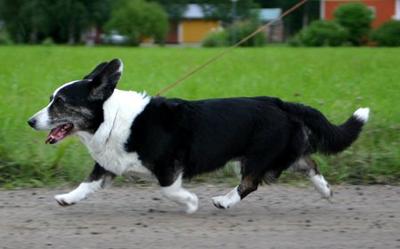|
Movement in the Cardigan |
||||||||
UK standard
Free
and active, elbows fitting close to sides, neither loose nor tied.
Forelegs reaching well forward without too much lift, in unison with
thrusting action of hind legs. US standard
Free
and smooth. Effortless. Viewed from the side, forelegs should reach well
forward when moving at a trot, without much lift, in unison with driving
action of hind legs. The correct shoulder assembly and well fitted elbows
allow for a long free stride in front. Viewed from the front, legs do not
move in exact parallel planes, but incline slightly inward to compensate
for shortness of leg and width of chest. Hind legs, when trotting, should
reach well under body, move on a line with the forelegs, with the hocks
turning neither in nor out, and in one continuous motion drive powerfully
behind, well beyond the set of the tail. Feet must travel parallel to the
line of motion with no tendency to swing out, cross over, or interfere
with each other. Short choppy movement, rolling or high-stepping gait,
close or overly wide coming or going, are incorrect. This is a herding dog
which must have the agility, freedom of movement, and endurance to do the
work for which he was developed. ***************** FORM
AND FUNCTION. Judges
learning about breeds hear this familiar line over and over.
The “Why“ of a breed – “why“ a breed is structured the
way it is and how that structure is related to the purpose and breed
function of getting a particular job done.
A pretty, typey Cardigan is only a function of how that pretty,
typey Cardigan moves to get the job done for which it was created. Cardigans
were bred to work the rough terrain of mountainous Wales.
A good Cardigan was invaluable to the farmer in driving the stock
to market or to drive home after grazing.
The Cardigan had to maintain a steady pace and work a long day and
not tire out. They were
efficient little power house machines getting the job done. The Cardigan does not work like the German Shepherd Dog, who were literally "moving fences", working along a particular line to control the flock. The Cardigan was originally a cattle dog rather than a sheep herding dog. They drive by barking, heeling and nosing - making short little runs back and forth at a full out gallop, forever dodging and nipping. Once the cattle is on the way in the right direction, he would fall back into a canter, or a trot. This is a working breed and as such it MUST be able to move freely
and with stamina. A working dog that cannot move is not efficient and
judges and breeders need to remember this. Every breed has been developed
for a purpose - a guard dog to guard; a terrier to hunt vermin; a herding
dog to work stock etc., so being able to move must be an essential part of
a Cardigan Welsh Corgi's breed characteristics.
If the dog has the correct structure as per the breed Standard then
it follows that it will move well. The
Cardigan should have a flexible and very strong back to be able to twist,
turn, gallop, and a strong rear to propel the dog along all those twists
and turns, and very strong forequarters to take the constant shock of all
that movement. The US Standard states:“The
hindquarters must denote sufficient power to propel this low, relatively
heavy herding dog efficiently over rough terrain.” This power is generated
in the rear and is conveyed by the spine to the front end.
The front end controls the brakes and the steering of the dog.
The length of stride of the forelegs must match the length of
stride of the rear legs. Each
front leg must be able to reach as far forward as each rear leg, as well
as drive back and follow through to the same degree. The
dog must posses a well angulated shoulder blade and upper arm, as well as
a high, well muscled shoulder which gives leverage and sufficient muscling
for effective rotation. Both front and rear paws must strike the ground at
the same angle. They must show the same amount of reach and the same
degree of follow through.
Cardigans
should move just like any other breed of dog with respect to good reach
from the shoulder, good drive and extension in the rear, a topline held
level without rolling, and with the head slightly lowered.
Cardigans should be shown on a loose lead, allowing them to bring
that head forward and down. The loin must be short for it is the bridge
linking the supportive rib cage to the hindquarters, and there is strength
in a short bridge. The tail
should drop, flowing behind and the dog will begin to drive from the rear. The well-angulated rear leg must move with strong drive
in line with the front leg with the foreleg moving smoothly forward under
the shoulder. There must be
smooth movement at the stifle, hock and pastern which aid in absorbing the
shock of movement. The
pads of the paw should be seen as the dog goes away, without any
noticeable weaving or extra movement at the hock joint. Cardigans
cannot single track due to the shortness of the leg and deep chest but
they tend to with legs that slightly converge towards the center line. The
movement appears strong, smooth and effortless.
Faults UK
standard: short stride,
choppy action, swinging in our out of the fore or hind limbs, high
stepping stride US: Feet must travel parallel to the
line of motion with no tendency to swing out, cross over, or interfere
with each other. Short choppy movement, rolling or high-stepping gait,
close or overly wide coming or going, are incorrect. The
Cardigan breed as a whole needs to strive for correct structure to improve
movement. There are few
Cardigans shown today which possess a good front and good rear-angulation.
Many of them are very straight in front and in the rear
and they may have adequate movement but no reach in front or in the rear. Limited
front reach that does not equal the rear extension may be caused by a
short upper arm. A stuffy neck may indicate a steep shoulder and/or forward
shoulder placement. This is
evident either standing or in moving. Cardigans
shown on tight leads will shift their weight to the rear and will move
very stilted. Many exhibitors
are running their dogs round the ring, not on a loose lead and it appears
to be acceptable. Judges must
have handlers move out on a loose lead and at a moderate trot.
The
breed does have some fine examples of correctly moving Cardigans and
breeders need to learn from them and judges should spot them easily and
will reward them. We
must strive for good reach in front with drive and extension in the rear,
a correct tail carriage for balance and a strong back with level topline. ********************** Gaits
The
term gait covers the pattern of footsteps at various rates of speed, each
pattern distinguished by a particular rhythm and footfall. The walk, trot,
canter and gallop are the most commonly recognized gaits in the Cardigan
Welsh Corgi. Trot
|
||||||||
|
|
|
|
|
The
canter is basically a slow form of gallop, and not as tiring. It has three
beats per stride, where one foreleg and both hind legs move more or less
together while the remaining foreleg or 'lead' leg moves seperately for
reasons of maintaining balance while turning.
The canter
The canter is a characteristic gait of the Cardigan Corgi. The UK breed
standard of 1933 under General appearance mentions "... a charming
characterstic dancing gait to his canter such as may be seen in no other
breed". And in his article What The Modern Corgi Owes To Its
Cardigan Ancestors, published in the American Kennel Gazette in 1935,
W. Lloyd Thomas when describing the gait of the original Cardigan Corgi
refers to a characteristic hopping action of the hind legs which always
occurred when cantering. This action which is a highly dominant characteristic is difficult to describe but once seen can
never be mistaken.
Gallop
:
The
fastest movement of the dog, the gallop, is a four-time gait in which the
dog is fully suspended or airborne once during each motion sequence. The
actual movement pattern is right front foot, left front foot, right rear
foot, left rear foot. Suspension occurs immediately after taking off from
the left rear foot.
Pace
:
The
pace is not desired in the show ring and is merely mentioned to complete
the picture. It is a two-beat lateral gait in which the legs on each side
move back and forth exactly as a pair causing a rolling motion of the
dog’s body. Structure and proportion (as well as fatigue) influence a
dog’s inclination to pace.
